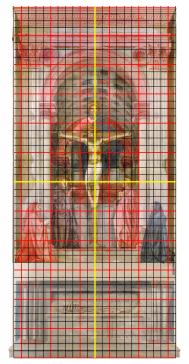The purpose of this Working Group project was to verify an alternative approach to the construction of the perspective composition of the Trinity fresco, forgetting for a moment the long tradition that attributes to Masaccio the correct use of the so-called costruzione legittima. It is reasonable to believe that the rule of Brunelleschi, whatever that may have been, emerged from practical geometry rather than from the reading of optical texts. And on this line, this exploration of the Trinity was made with a particular attention to the kind of geometry eventually available in the workshops thanks to the abacus tradition; the kind of geometry on which Leon Battista Alberti wrote in his Elementa picturae. A photogrammetric survey of the lines impressed on the plaster was made during the last restoration, in 2000, and serves as the base on which the present study is carried out. Examination of the signs marked on the plaster reveals refined geometric expertise that allows us to interpret the drawing of the Trinity even without recurring to the perspective principles of Alberti and his followers. There are no signs traced at random. Everything appears to have been scrupulously measured. But there is no evidence that he applied the rule traditionally attributed to Brunelleschi. What becomes apparent instead is that the painter performed a geometrical transformation of the type described later by Alberti in his Elementa picturae, obtaining the "comminuted" form of the barrel-vault from its "concentric" image, that is, from the plan, without recurring to perspective projection.

Masaccio, Holy Trinity, fresco, Florence, Santa Maria Novella: the proportional grid, based on the signs impressed on the plaster, is measured according to the Florentine "braccio da terra," a unit of measurement used by surveyors (55.12 cm).
Project
(2012-2014)
Masaccio's Elements of Painting: Geometrical Practice in the Trinity Fresco
- Filippo Camerota
